Every year in early autumn, the Netherlands Film Festival (NFF) takes place. For ten days, the city of Utrecht is the cinema capital of the Netherlands, and we join the fun with our own Unofficial Dutch Film Star Postcards Festival (UDFSPF). Today's star is the 'Dutch Louise Brooks', Truus van Aalten (1910-1999). In the 1920s and early 1930s, she made 28 films in Germany and Austria, but only one in the Netherlands. The Germans lovingly called her die kleine holländische Käse (the little Dutch cheese).

German postcard by Ross Verlag, no. 4549/1, 1929-1930. Photo: Alex Binder, Berlin.
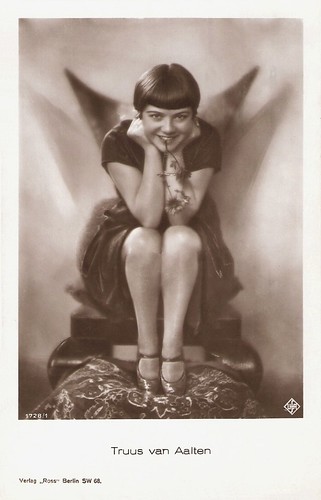
German postcard by Ross Verlag, no. 1720/1, 1927-1928. Photo: Ufa.
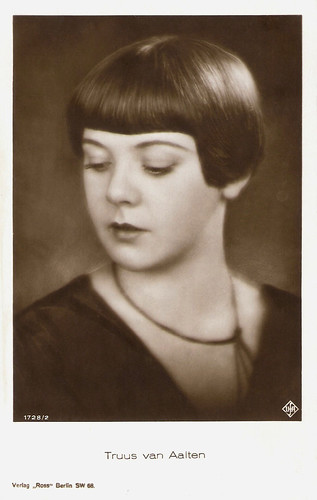
German postcard by Ross Verlag, no. 1728/2, 1927-1928. Photo: Ufa.
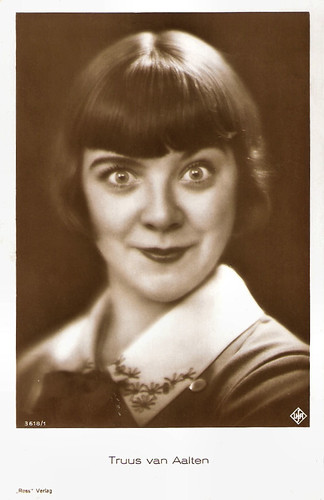
German postcard by Ross Verlag, no. 3618, 1928-1929. Photo: Ufa. Collection: Geoffrey Donaldson Institute.

German postcard by Ross Verlag, no. 3823/1, 1928-1929. Photo: Hegewald Film. Collection: Geoffrey Donaldson Institute.
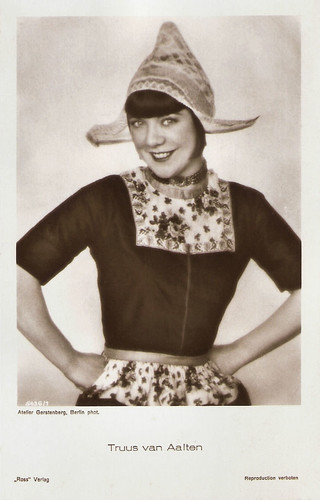
German postcard by Ross Verlag, no. 6436/1, 1931-1932. Photo: Atelier Gerstenberg, Berlin.
Geertruida Everdina Wilhelmina van Aalten was born in the city of Arnhem, in 1910. She was the daughter of high-street chemist Fransciscus (Frans) van Aalten and his wife Geertruida van den Anker.
Film crazy Truus was only sixteen when she won a competition by the Ufa in Dutch film magazine De Rolprent (The Moving Picture) in the summer of 1926. Soon she went to the film metropolis of Europe at the time: Berlin. By 1926, Universum Film A.G. (Ufa), was the main German film studio. From its Berlin studios at Neubabelsberg, Ufa had produced monumental films like Fritz Lang’s Die Nibelungen in 1923 and the Sci-Fi masterpiece Metropolis (Fritz Lang, 1926).
Truus' film was called Die sieben Töchter der Frau Gyurkovics/A Sister of Six (Ragnar Hyltén-Cavallius, 1927) and starred handsome idol, Willy Fritsch. Her role was just a small, uncredited part. None of the other five unknown 'daughters' from Frau Gyurkovics would survive in the film industry, but the Ufa would soon realise that Truus was a gifted comedienne.
Truus returned to the Netherlands after the shooting of the film had finished. Only two days after she had returned home, a telegram arrived from the Ufa: IMMEDIATELY TO BERLIN - 3 YEAR CONTRACT. Truus had had no acting education at all, but she was sparkly and funny and the camera liked her. The Ufa put Truus into her next film - and she had a much bigger part now. Die Selige Exzellenz/His Holy Lordship (Adolf E. Licho, Wilhelm Thiele, 1927) was a comedy starring Willy Fritsch and Olga Tschechova.
Soon more small parts in other silent films followed, like in the romantic comedy Der moderne Casanova/A Modern Casanova (Max Obal, Rudolf Walther-Fein, 1928) with Harry Liedtke. Truus was often lent out to other film companies and appeared in many cinema commercials and magazine promotions. Because of her informal acting and her humour, Truus' nickname in Germany became die kleine holländische Käse (the little Dutch cheese).

German postcard by Ross Verlag, no. 3115/1, 1928-1928. Photo: Hanni Schwarz, Berlin.
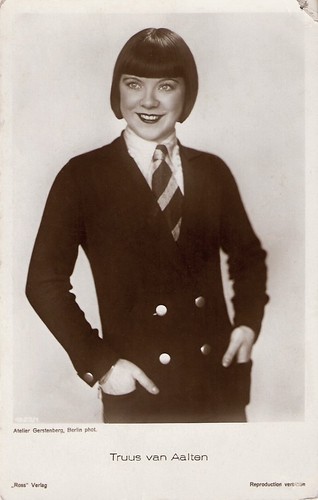
German postcard by Ross Verlag, no. 4029/1, 1929-1930. Photo: Gerstenberg, Berlin.
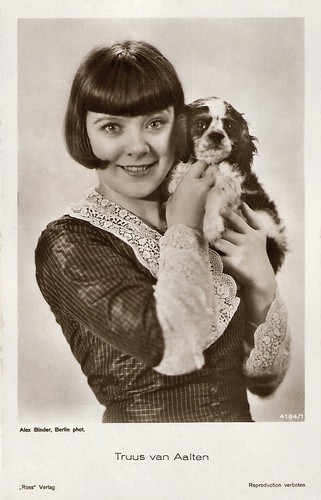
German postcard by Ross Verlag, no. 4184/1, 1929-1930. Photo: Atelier Binder, Berlin.
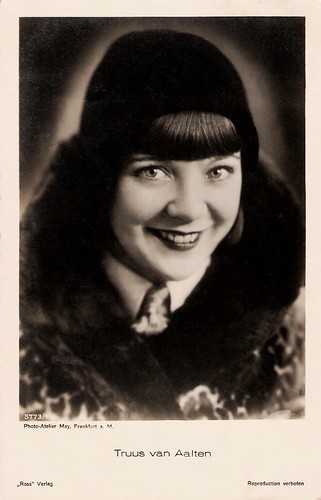
German postcard by Ross Verlag, no. 5773/1, 1930-1931. Photo: Photo-Atelier May, Frankfurt a.M.

German postcard by Ross Verlag, no. 6584/1, 1931-1932. Photo: Atelier Binder, Berlin.
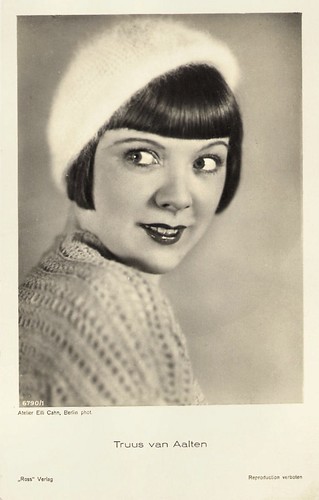
German postcard by Ross Verlag, no. 6790/1, 1931-1932. Photo: Eli Cahn, Berlin.
Young and irreverent, Truus van Aalten became affectionately known in Germany as a Backfisch (literally meaning fish to fry). The new, 1920s girl was boyish yet feminine - short hair, gawky limbs, a young flapper on the edge of sexuality. Truus posed for photos and gave interviews for film magazines all over Europe. Truus even ended up in American movie magazines advertising Lux soap.
In 1929, Dutch director Jaap Speyer, took Truus back to the Netherlands to shoot scenes for Jenny's Bummel durch die Männer/Jenny's Stroll Through The Men (Jaap Speyer, 1929). News cameras caught up with the unit filming one sunny day on Scheveningen pier, and Dutch cinema audiences saw it all in their newsreels a few days later. Her next film, Der Sonderling/The Oddball (Walter Jerven, 1929) gave Truus the chance to work with the great comedian Karl Valentin as his cute and naughty counterpart.
The transition to the sound film turned out well for van Aalten despite her Dutch origin. Truus entered talking pictures by courtesy of experienced director Max Mack, who was about to shoot a new film starring Daisy d'Ora, Nur am Rhein.../Only On The Rhein... (Max Mack, 1930), and he wanted Truus to play Daisy's pal Lore. Mack signed her without requiring a microphone test - news of which spread around the film community like wildfire.
The public didn’t hold her Dutch accent against her. Truus was becoming really well known now - film magazines like Filmwoche and Filmwelt featured articles about das Mädchen aus Holland (that girl from Holland), Ross Verlag, and other main publishers were issuing postcards of her. For the first time, she got top billing in the popular comedy Susanne macht Ordnung/Susanne Cleans Up (Eugen Thiele, 1930) in which she played a schoolgirl in search of her missing father.
Next she performed in such early sound films as Liebling der Götter/Darling of the Gods (Hanns Schwarz, 1930) with Emil Jannings, Pension Schöller (Georg Jacoby, 1930), and Kasernenzauber/Magic of the Barracks (Carl Boese, 1931) with Igo Sym.

German postcard by Ross Verlag, no. 4457/1, 1929-1930. Photo: Atelier Balázs, Berlin.
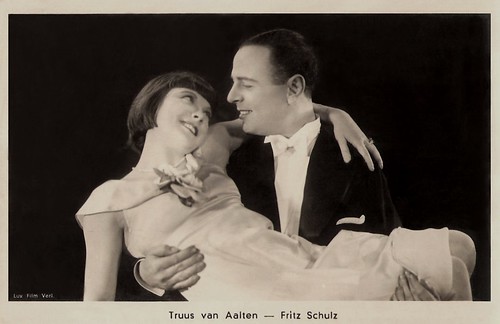
Austrian postcard by Iris-Verlag, no. 6538. Photo: Lux Film Verl. Publicity still for Der Bettelstudent/The Beggar Student (Victor Janson, 1931) with Fritz Schulz.

German postcard by Ross Verlag, no. 5774/1, 1930-1931. Photo: Atelier Tannenwald, Wiesbaden.

Austrian postcard by Iris Verlag, no. 6533. Photo: Lux Film.
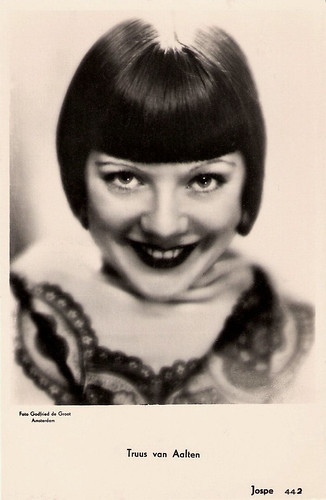
Dutch postcard by Jospe, no. 442. Photo by Godfried de Groot, Amsterdam.
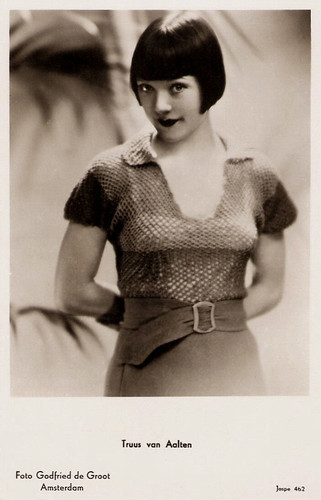
Dutch Postcard by JosPe, Arnhem, no. 462. Photo: Godfried de Groot, Amsterdam.
By 1932, Truus van Aalten had outgrown her backfish image. She was a mature woman now, an experienced actress, but she was always typecast as a light comedy player. When the Nazis came to power, foreigners were subject to a quota system restricting how much they could work. Truus had not become a party member, and when the Nazis tried to use her in propaganda films, she refused.
Tired of the struggle to find work, she took the train and went to Vienna in Austria. There, German director Georg Jacoby offered her a part in the Viennese operetta G'schichten aus dem Wienerwald/Tales From The Vienna Woods (Georg Jacoby, 1934), about an ordinary girl who swaps places with an American millionaire's daughter. In Austria, Magda Schneider was on board as the lead, and Truus played the rich girl. The successful film showed her new, mature look and her bleached blonde hair.
Next van Aalten starred in the Dutch army comedy Het meisje met den blauwen hoed/The Girl with the Blue Hat (Rudolf Meinert, 1934) opposite Roland Varno. Although the film was a success in the Netherlands, it was not distributed abroad. Therefore Truus decided not to continue working in the young Dutch film industry.
After a long break, she got a role in Ein ganzer Kerl/A Regular Fellow (Fritz Peter Buch, 1939), a typical film of the Nazi era. Heidemarie Hatheyer played the lead as Jule, a strong, self-willed woman who refuses to be ruled by the men in her life. By the end of the film, she has realised her wrong-headedness, swapped her riding pants for a pretty dress, and become the housewife she was destined to be. Truus played a character called Anni, a widow, and brought vivacity and humour to the part. Ein ganzer Kerl had its premiere in Berlin in January 1940. It would be Truus' last film.
After the war, she tried to gain a foothold in Hollywood and in the British film business, but the there unknown actress finally failed because of her lack of knowledge of the English language. In the 1950s she became a businesswoman with a wholesale business importing and exporting Dutch souvenirs and promotional items, and in 1964 she married her employee Henk Godwaldt. Her last years were marred by mental illness.
Truus van Aalten died in the city of Warmond, the Netherlands, in 1999. Her archive has been donated to the Dutch Film Museum (now Eye Filmmuseum) in Amsterdam.

Dutch postcard especially printed for N.V. De Faam, P.A. de Bont's chocolate and sweets factory, Breda. Photo: Ufa.
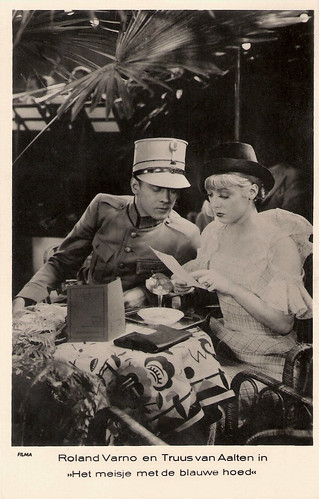
Dutch postcard by M. B. & Z. (M. Bonnist & Zonen, Amsterdam). Photo: Filma. Publicity still for Het Meisje met de Blauwe Hoed/The girl with the blue Hat (Rudolf Meinert, 1934) with Roland Varno.

Dutch postcard by M. B.& Z. (M. Bonnist & Zonen, Amsterdam). Photo: Filma. Publicity still for Het Meisje met de Blauwe Hoed/The girl with the blue Hat (Rudolf Meinert, 1934) with Roland Varno, Dries Krijn and Lou Bandy.
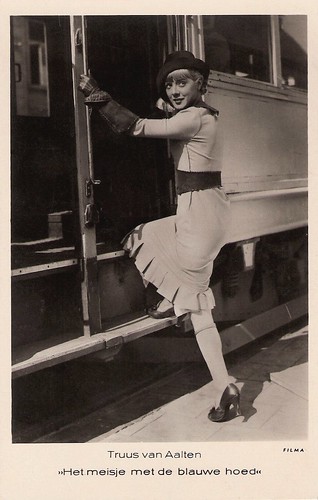
Dutch postcard by M. B. & Z. (M. Bonnist & Zonen, Amsterdam). Photo: Filma. Publicity still for Het meisje met den blauwen hoed/The girl with the blue Hat (Rudolf Meinert, 1934). Collection: Geoffrey Donaldson Institute.
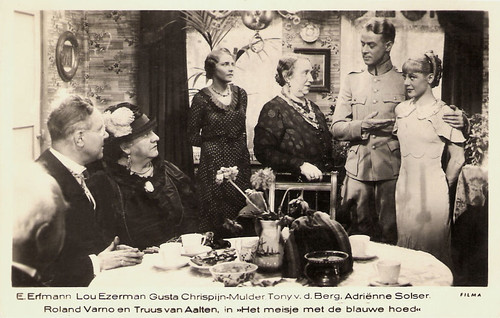
Dutch postcard by M. B. & Z. (M. Bonnist & Zonen, Amsterdam). Photo: Filma. Publicity still for Het Meisje met de Blauwe Hoed/The girl with the blue Hat (Rudolf Meinert, 1934) with Lau Ezerman, Gusta Chrispijn-Mulder, Tony van den Berg, Adriënne Solser and Roland Varno.
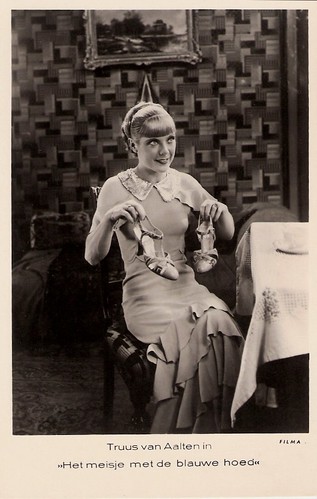
Dutch postcard by M. B. & Z. (M. Bonnist & Zonen, Amsterdam). Photo: Filma. Publicity still for Het Meisje met de Blauwe Hoed/The girl with the blue Hat (Rudolf Meinert, 1934).
Sources: Roger Mitchell (Truus van Aalten), Thomas Staedeli (Cyranos), Wikipedia (English and Dutch) and IMDb.

German postcard by Ross Verlag, no. 4549/1, 1929-1930. Photo: Alex Binder, Berlin.

German postcard by Ross Verlag, no. 1720/1, 1927-1928. Photo: Ufa.

German postcard by Ross Verlag, no. 1728/2, 1927-1928. Photo: Ufa.

German postcard by Ross Verlag, no. 3618, 1928-1929. Photo: Ufa. Collection: Geoffrey Donaldson Institute.

German postcard by Ross Verlag, no. 3823/1, 1928-1929. Photo: Hegewald Film. Collection: Geoffrey Donaldson Institute.

German postcard by Ross Verlag, no. 6436/1, 1931-1932. Photo: Atelier Gerstenberg, Berlin.
Film Metropolis Berlin
Geertruida Everdina Wilhelmina van Aalten was born in the city of Arnhem, in 1910. She was the daughter of high-street chemist Fransciscus (Frans) van Aalten and his wife Geertruida van den Anker.
Film crazy Truus was only sixteen when she won a competition by the Ufa in Dutch film magazine De Rolprent (The Moving Picture) in the summer of 1926. Soon she went to the film metropolis of Europe at the time: Berlin. By 1926, Universum Film A.G. (Ufa), was the main German film studio. From its Berlin studios at Neubabelsberg, Ufa had produced monumental films like Fritz Lang’s Die Nibelungen in 1923 and the Sci-Fi masterpiece Metropolis (Fritz Lang, 1926).
Truus' film was called Die sieben Töchter der Frau Gyurkovics/A Sister of Six (Ragnar Hyltén-Cavallius, 1927) and starred handsome idol, Willy Fritsch. Her role was just a small, uncredited part. None of the other five unknown 'daughters' from Frau Gyurkovics would survive in the film industry, but the Ufa would soon realise that Truus was a gifted comedienne.
Truus returned to the Netherlands after the shooting of the film had finished. Only two days after she had returned home, a telegram arrived from the Ufa: IMMEDIATELY TO BERLIN - 3 YEAR CONTRACT. Truus had had no acting education at all, but she was sparkly and funny and the camera liked her. The Ufa put Truus into her next film - and she had a much bigger part now. Die Selige Exzellenz/His Holy Lordship (Adolf E. Licho, Wilhelm Thiele, 1927) was a comedy starring Willy Fritsch and Olga Tschechova.
Soon more small parts in other silent films followed, like in the romantic comedy Der moderne Casanova/A Modern Casanova (Max Obal, Rudolf Walther-Fein, 1928) with Harry Liedtke. Truus was often lent out to other film companies and appeared in many cinema commercials and magazine promotions. Because of her informal acting and her humour, Truus' nickname in Germany became die kleine holländische Käse (the little Dutch cheese).

German postcard by Ross Verlag, no. 3115/1, 1928-1928. Photo: Hanni Schwarz, Berlin.

German postcard by Ross Verlag, no. 4029/1, 1929-1930. Photo: Gerstenberg, Berlin.

German postcard by Ross Verlag, no. 4184/1, 1929-1930. Photo: Atelier Binder, Berlin.

German postcard by Ross Verlag, no. 5773/1, 1930-1931. Photo: Photo-Atelier May, Frankfurt a.M.

German postcard by Ross Verlag, no. 6584/1, 1931-1932. Photo: Atelier Binder, Berlin.

German postcard by Ross Verlag, no. 6790/1, 1931-1932. Photo: Eli Cahn, Berlin.
Backfish
Young and irreverent, Truus van Aalten became affectionately known in Germany as a Backfisch (literally meaning fish to fry). The new, 1920s girl was boyish yet feminine - short hair, gawky limbs, a young flapper on the edge of sexuality. Truus posed for photos and gave interviews for film magazines all over Europe. Truus even ended up in American movie magazines advertising Lux soap.
In 1929, Dutch director Jaap Speyer, took Truus back to the Netherlands to shoot scenes for Jenny's Bummel durch die Männer/Jenny's Stroll Through The Men (Jaap Speyer, 1929). News cameras caught up with the unit filming one sunny day on Scheveningen pier, and Dutch cinema audiences saw it all in their newsreels a few days later. Her next film, Der Sonderling/The Oddball (Walter Jerven, 1929) gave Truus the chance to work with the great comedian Karl Valentin as his cute and naughty counterpart.
The transition to the sound film turned out well for van Aalten despite her Dutch origin. Truus entered talking pictures by courtesy of experienced director Max Mack, who was about to shoot a new film starring Daisy d'Ora, Nur am Rhein.../Only On The Rhein... (Max Mack, 1930), and he wanted Truus to play Daisy's pal Lore. Mack signed her without requiring a microphone test - news of which spread around the film community like wildfire.
The public didn’t hold her Dutch accent against her. Truus was becoming really well known now - film magazines like Filmwoche and Filmwelt featured articles about das Mädchen aus Holland (that girl from Holland), Ross Verlag, and other main publishers were issuing postcards of her. For the first time, she got top billing in the popular comedy Susanne macht Ordnung/Susanne Cleans Up (Eugen Thiele, 1930) in which she played a schoolgirl in search of her missing father.
Next she performed in such early sound films as Liebling der Götter/Darling of the Gods (Hanns Schwarz, 1930) with Emil Jannings, Pension Schöller (Georg Jacoby, 1930), and Kasernenzauber/Magic of the Barracks (Carl Boese, 1931) with Igo Sym.

German postcard by Ross Verlag, no. 4457/1, 1929-1930. Photo: Atelier Balázs, Berlin.

Austrian postcard by Iris-Verlag, no. 6538. Photo: Lux Film Verl. Publicity still for Der Bettelstudent/The Beggar Student (Victor Janson, 1931) with Fritz Schulz.

German postcard by Ross Verlag, no. 5774/1, 1930-1931. Photo: Atelier Tannenwald, Wiesbaden.

Austrian postcard by Iris Verlag, no. 6533. Photo: Lux Film.

Dutch postcard by Jospe, no. 442. Photo by Godfried de Groot, Amsterdam.

Dutch Postcard by JosPe, Arnhem, no. 462. Photo: Godfried de Groot, Amsterdam.
Souvenirs
By 1932, Truus van Aalten had outgrown her backfish image. She was a mature woman now, an experienced actress, but she was always typecast as a light comedy player. When the Nazis came to power, foreigners were subject to a quota system restricting how much they could work. Truus had not become a party member, and when the Nazis tried to use her in propaganda films, she refused.
Tired of the struggle to find work, she took the train and went to Vienna in Austria. There, German director Georg Jacoby offered her a part in the Viennese operetta G'schichten aus dem Wienerwald/Tales From The Vienna Woods (Georg Jacoby, 1934), about an ordinary girl who swaps places with an American millionaire's daughter. In Austria, Magda Schneider was on board as the lead, and Truus played the rich girl. The successful film showed her new, mature look and her bleached blonde hair.
Next van Aalten starred in the Dutch army comedy Het meisje met den blauwen hoed/The Girl with the Blue Hat (Rudolf Meinert, 1934) opposite Roland Varno. Although the film was a success in the Netherlands, it was not distributed abroad. Therefore Truus decided not to continue working in the young Dutch film industry.
After a long break, she got a role in Ein ganzer Kerl/A Regular Fellow (Fritz Peter Buch, 1939), a typical film of the Nazi era. Heidemarie Hatheyer played the lead as Jule, a strong, self-willed woman who refuses to be ruled by the men in her life. By the end of the film, she has realised her wrong-headedness, swapped her riding pants for a pretty dress, and become the housewife she was destined to be. Truus played a character called Anni, a widow, and brought vivacity and humour to the part. Ein ganzer Kerl had its premiere in Berlin in January 1940. It would be Truus' last film.
After the war, she tried to gain a foothold in Hollywood and in the British film business, but the there unknown actress finally failed because of her lack of knowledge of the English language. In the 1950s she became a businesswoman with a wholesale business importing and exporting Dutch souvenirs and promotional items, and in 1964 she married her employee Henk Godwaldt. Her last years were marred by mental illness.
Truus van Aalten died in the city of Warmond, the Netherlands, in 1999. Her archive has been donated to the Dutch Film Museum (now Eye Filmmuseum) in Amsterdam.

Dutch postcard especially printed for N.V. De Faam, P.A. de Bont's chocolate and sweets factory, Breda. Photo: Ufa.

Dutch postcard by M. B. & Z. (M. Bonnist & Zonen, Amsterdam). Photo: Filma. Publicity still for Het Meisje met de Blauwe Hoed/The girl with the blue Hat (Rudolf Meinert, 1934) with Roland Varno.

Dutch postcard by M. B.& Z. (M. Bonnist & Zonen, Amsterdam). Photo: Filma. Publicity still for Het Meisje met de Blauwe Hoed/The girl with the blue Hat (Rudolf Meinert, 1934) with Roland Varno, Dries Krijn and Lou Bandy.

Dutch postcard by M. B. & Z. (M. Bonnist & Zonen, Amsterdam). Photo: Filma. Publicity still for Het meisje met den blauwen hoed/The girl with the blue Hat (Rudolf Meinert, 1934). Collection: Geoffrey Donaldson Institute.

Dutch postcard by M. B. & Z. (M. Bonnist & Zonen, Amsterdam). Photo: Filma. Publicity still for Het Meisje met de Blauwe Hoed/The girl with the blue Hat (Rudolf Meinert, 1934) with Lau Ezerman, Gusta Chrispijn-Mulder, Tony van den Berg, Adriënne Solser and Roland Varno.

Dutch postcard by M. B. & Z. (M. Bonnist & Zonen, Amsterdam). Photo: Filma. Publicity still for Het Meisje met de Blauwe Hoed/The girl with the blue Hat (Rudolf Meinert, 1934).
Sources: Roger Mitchell (Truus van Aalten), Thomas Staedeli (Cyranos), Wikipedia (English and Dutch) and IMDb.
2 comments:
I love these sepia postcards of a lovely actress that I've never seen on the screen unfortunately! :)
Hi MaryT - have a look at truusvanaalten.com for Truus' full story - it even has links to movie clips of her on Youtube.
Post a Comment